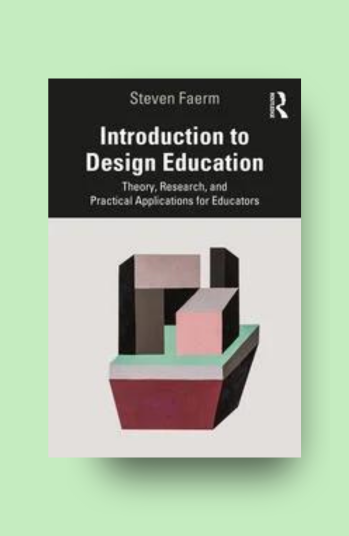Book Review: Introduction to Design Education
Dan China, Former Senior Art Adviser, consultant and maker, reviews ‘Introduction to Design Education’ by Steven Faerm. Read on to learn more about this significant new book about design education.

Introduction to Design Education: Theory, Research, and Practical Applications for Educators written by Steven Faerm includes contributions from internationally acclaimed educators, writers and designers. Introduction to Design Education is written to support design educators in H.E. who may begin their teaching career with no pedagogical training. Despite being rooted in the US context this book transcends geographical boundaries. It is written with great insight, scholarship and understanding of design, teaching, learning. But more than this it is written with genuine care and affection for both the subject and the emerging generation of designers and their teachers. This alone makes it a pleasure to read and a book that will enrich all educators in the field of design education. For those new to teaching design to undergraduates it is almost essential reading and will inform their career for many years to come.
The book contains four sections:
Section 1: Design Industries: This section provides a lucid and clear review of the past, present and future of design and the design industries. Most significantly it tracks the changing role and responsibilities of designers in 21st century. The book considers the evolving role of designers, who in the 20th century, were primarily concerned with object-driven outcomes, improving products and environments. It notes that this will no longer be the case for designers in the 21st century, who will increasingly be focused on knowledge and service-driven outcomes. Students of design will increasingly need to understand the difference between systems-oriented work and simply producing stuff. The section is well supported by case studies from the fashion industry and an interview with the director of a leading design management company. This reflects on the increasingly significant concept of Human Centred Design (HCD) in this field.
Section 2: Design Education: This section describes the origins and continuing evolution of the US design education. However, it draws on international references and reflects on global history and directions in design education: tracking significant milestones from European craft guilds through the École des Beaux-Arts to the Bauhaus which became a seminal influence on design as it’s teachers moved to the US after it closed in 1933. This section also includes contributions from Argentina, China, Italy and the UK. These describe ways that history, sociology-political systems, communities and cultures shape design industries and approaches to design education across the globe. Although some aspects of this section refer primarily to the American experience, there is a great deal here that will be relevant to the international audience of design educators.
Section 3: Design Pedagogy: The chapters in this section consider a range of topics and issues related to the professional pedagogy of design educators and the cognitive and emotional development of the emergent generation of design undergraduates. It presents a comprehensive view of the evolving role of the design educator and some of the key attributes that can be found among highly effective educators.
Section 4: Design Classrooms: This is by far the largest section of the book and offers a wide selection of well researched and explained pedagogical techniques. These present the reader with key concepts, attendant research and practical examples of professional practice which illustrate and illuminate effective teaching. It includes an examination of young adult development, teaching as performance and effective interpersonal skills that build trust and motivation. In addition to describing features of effective classroom and lesson strategies, it includes chapters on issues such as inclusive classrooms, assessment, faculty mentorship. This is informed by practical examples of plans, policies, principles, syllabus, and curriculum building.
This book is ostensibly written for experienced designers who have made the move into education. Their experience of teaching pedagogy is often limited to their own experience, and they are expected to ‘pick it up’ as they go on. The author has provided a very comprehensive text to inform their work and help them to become a ‘good’ teacher. However, when the author talks authoritatively about design, he talks to all of us. When he talks about design education in different parts of the world, he places all of our teaching in context. When he talks about design pedagogy he does so without the accumulated accretion of those layers of jargon and policies which can, over time, obscure our understanding. We read this informed, common-sense discussion about pedagogy with a fresh eye and renewed understanding. When he describes effective classrooms and practical teaching strategies it encourages all of us to reflect and refresh our own practice. These may not be new insights, but they are renewed insights. It is perhaps a truism that we all learn from our peers. If so, this is a book that we can all learn something from.
Introduction to Design Education: Theory, Research, and Practical Applications for Educators by Steven Faerm published by Routledge is out now. Buy your copy.
About the Reviewer:
Dan China is a former senior adviser for art and creativity. He has been a teacher, examiner and lecturer for art education and has been both Chair and Secretary of the U.K. Art Adviser’s Association. As a consultant he has worked to develop the art curriculum in Kazakhstan and recently for the Kingdom of Saudi Arabia.
About the Author:
Steven Faerm is Associate Professor of Fashion at Parsons School of Design, New York. He has been teaching for over twenty years and his books have been translated into nine languages. His research into design education, teaching and learning and young adult development is widely recognised and has been published in leading academic journals and publications.